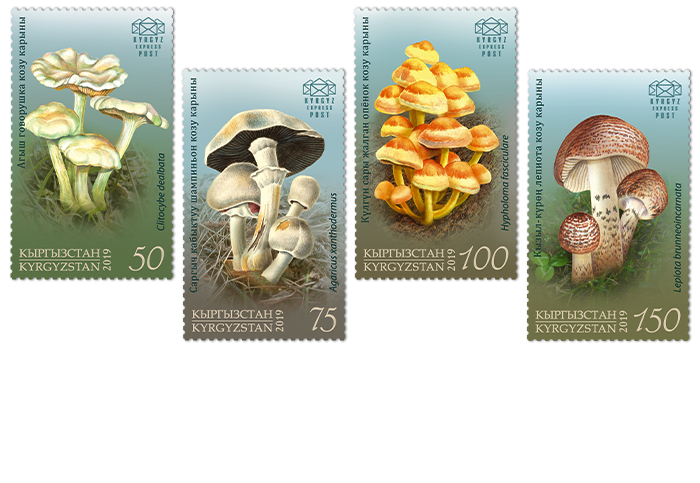
Poisonous Mushrooms of Kyrgyzstan
11 March 2019In 2017, KEP stamps dedicated to edible mushrooms of Kyrgyzstan were issued. The mycological theme is continued in 2019 but this time the postage stamps are dedicated to poisonous mushrooms.
Toxins in certain types of fungi can cause great harm to human health. Sometimes careless use of poisonous mushrooms can be fatal. Therefore, great caution needs to be taken when harvesting them.
However, despite their potential danger, poisonous mushrooms, as an integral part of nature, play an important role in the biological diversity of our planet. Some types of poisonous mushrooms are very rare and need protection from humans.
It is also important to note that some active substances contained in poisonous mushrooms can have a therapeutic effect in the treatment of certain diseases. Modern medicine is actively exploring these substances, offering new and effective drugs.
The new KEP stamps represent four types of poisonous mushrooms which can be found in Kyrgyzstan: Ivory Funnel, Yellow-staining Mushroom, Sulfur Tuft and Deadly Dapperling.
Ivory Funnel (Clitocybe dealbata) is a poisonous fungus containing the highly toxic substance, muscarine, which can lead to severe forms of poisoning. Usually this fungus grows in meadows and pastures or on the edges of deciduous forests.
Yellow-staining Mushroom (Agaricus xanthodermus) is a poisonous species of mushroom belonging to the genus Agaricus. Unlike the edible species, the Yellow-staining Mushroom has an unpleasant odor, which is enhanced by cooking.
Sulfur Tuft (Hypholoma fasciculare) is a poisonous fungus, distinguished by lamella (gills) with a sulfur-yellow colour, which distinguish it from edible mushrooms. It grows predominantly on rotting hardwood.
Deadly Dapperling (Lepiota brunneoincarnata) is one of the most dangerous poisonous mushrooms, containing nitriles and cyanides. It is found growing both individually and in groups, in forests, parks and gardens.
KEP hopes that the new stamp issue will arouse great interest among collectors and all fans and defenders of the natural world of Kyrgyzstan.
Also, we would like to express our sincere gratitude to the scientists of the Institute of Biology and Soil Sciences of the National Academy of Sciences of the Kyrgyz Republic, in particular to Ms. Svetlana Mosolova, head of the Laboratory of Mycology and Phytopathology, for valuable advice in preparing this issue of KEP postage stamps.
You can check the newsletter for the new KEP issue here
Stamps and FDC can be purchased here



